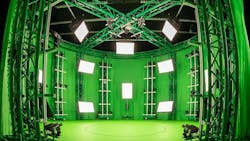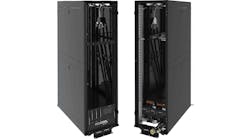Holograms in the Data Center: Cutting-Edge 3D Studio at Sabey Ashburn
Like most of the data centers in Northern Virginia, the Sabey Data Centers campus contains large data halls filled with servers and storage equipment. But the Sabey site in Ashburn also houses a unique facility pioneering a virtual future.
The Avatar Dimension facility houses a sound-proof studio filled with cameras, bright lights and a wrap-around green screen. Inside, they’re making holograms.
The process is known as volumetric capture, and uses specialized cameras that surround a person or object and convert the image data into holographic 3D creations that look real from any angle.
Rapper Flo Rida recently used the new studio to record a 3D performance of his song “Low” as an NFT (Non-Fungible Token), a digital collectible. His performance – and the Avatar Dimension technology – was just featured on a “60 Minutes” segment about the rise of metaverse experiences.
It’s a long way from memories of fuzzy holograms in science fiction movies like Star Wars (“Help me, Obi-Wan Kenobi”). Holograms are now science reality, as photorealistic digital humans blend the digital and physical worlds to create training and entertainment experiences for many industries.
Sabey Corporation Chairman David Sabey says Avatar Dimension’s holographic technology can “expand the limitless benefits of a new digital frontier.” Sabey believes holograms will enable many new types of remote digital experiences.
“As we’ve seen through the pandemic, the Internet immediately met the challenges presented by providing virtual tools for society to help replicate the real day-to-day life experience,” said Sabey.
Sabey Corporation is the lead investor in Avatar Dimension, partnering with London’s Dimension Studio and St. Louis-based video creative agency Avatar Studios. The studio they’ve created in Ashburn is one of just seven in the world that is certified as a Microsoft Mixed Reality Capture Studio.
Next-Gen Tech as a Data Center Opportunity
Sabey’s work with Avatar Dimension is an example of how data centers play a key role in the next-generation technologies transforming society. Hologram creation involves massive digital files that benefit from low-latency access to large-scale servers and storage. Location matters for data-intensive creative processes, and this data gravity could create new possibilities in technology real estate.
Sabey is also one of several data centers in Ashburn that are serving as testbeds for new technologies, performing engineering tests atop the world’s largest intersection of networks and fiber. Ashburn is known as “Data Center Alley” for its abundance of cloud computing facilities, with more than 100 data centers spanning 10 million-plus square feet. Other examples include the Co-Innovation Facility at the new Equinix DC21 data center, and an advanced cooling lab at Digital Realty’s Building L.
The 4,000 square foot studio inside the Sabey Data Center includes a green room, client area, and offices, as well as the sound-proof studio housing a circular array of 70 Volucam 12-megapixel cameras. The subject is positioned in a brightly-lit 8-foot circle at the center of the studio, and the high-resolution cameras work together to capture the performer from every angle. The video files are merged to create 3-dimensional holograms.
“The cameras create enormous files, which are merged using Microsoft’s leading technology,” said architect Kyle MertensMeyer, the facility designer, in a virtual tour of the Ashburn facility. “These files are so large – terabytes and terabytes – that they can take many hours to transform into the final product.”
That’s why the facility is ideal for a data center, with ultra-low-latency access to powerful processing and storage. The process was demonstrated in the 60 Minutes segment filmed at the Ashburn facility, in which CBS correspondent Laurie Segall was turned into a hologram and inserted into a digital landscape. Here’s a portion of the segment, featuring a discussion of NFTs and the pandemic-driven surge in metaverse experiences.
During its pre-operational phase, Avatar Dimension did a number of projects for clients ranging from enterprise, military and government agencies to marketers, games, fashion and entertainment. Some examples:
- The 2020 Air Force Global Futures Report, where a chief U.S. Air Force futurist was turned into a holographic presenter for a report using virtual reality.
- The COCA (Center of Creative Arts) Virtual Web Tour, the first-ever online experience that marries 360° images with photo realistic holograms to bring viewers inside the newly-renovated St. Louis campus guided by 3D docents.
- The Microsoft Ignite 2021 Keynote, where 3D holograms of marine biologists Edie Widder and Vincent Pieribone were captured as part of the Microsoft Mesh virtual presentation in AltSpace VR.
- Fashion house Balenciaga’s Afterworld The Age of Tomorrow, where hologram models were created for its 3D virtual catwalk experience.
The rising popularity of NFTs is another potential growth area for holograms. These digital expressions of art, music and sports highlights use blockchain technology to validate ownership of online assets. Flo Rida is an investor in Emmersive Entertainment, which produces NFTs to extend the brands of athletes, artists, musicians and online creators.
A New Frontier in Tech Real Estate?
NFTs are one of many initiatives to harness holograms to boost engagement with fans, influencers and collectors. These could include holographic concerts in which digital performers are beamed into homes or other remote venues, or allowing fans to interact with holograms of their favorite artists in social media posts. As the technology matures, new use cases are likely to emerge.
That’s certainly the view at Microsoft, whose technology plays a prominent role in Avatar Dimension’s operation. Microsoft has been a pioneer in holograms through its HoloLens mixed reality glasses and even holographic data storage.
An aerial view of the Sabey Data Centers campus in Ashburn, Virginia. (Photo: Sabey Data Centers)
“Content creators are increasingly engaging volumetric video as a new medium to bring viewers more immersive, connected human experiences” says Steve Sullivan, General Manager of Microsoft Mixed Reality Capture Studios. “Our mission is to deliver high-quality, accessible, affordable human holograms to fuel the growth of Mixed Reality, and we’re thrilled that Avatar Dimension will be our studio partner in Washington D.C., bringing this technology to the East Coast.”
It’s also clearly an opportunity for Sabey Data Centers, one of the industry’s most experienced players, with more than 25 years of experience in the data center business. The company operates more than 3 million square feet of mission-critical space, making it one of the largest privately-held multi-tenant data center operators in the United States, with campuses in three sites across the Pacific Northwest, Manhattan and two data centers on the Ashburn campus.
The Seattle-based company initially focused on commercial development, including office and industrial space for major Seattle corporations like Boeing and Starbucks.
But Sabey has also been attuned to the ways that technology drives the need for specialized real estate. The company diversified into data center real estate, as well as technical facilities for life sciences and healthcare. Avatar Dimension is a next step toward the emerging frontier in tech real estate.






